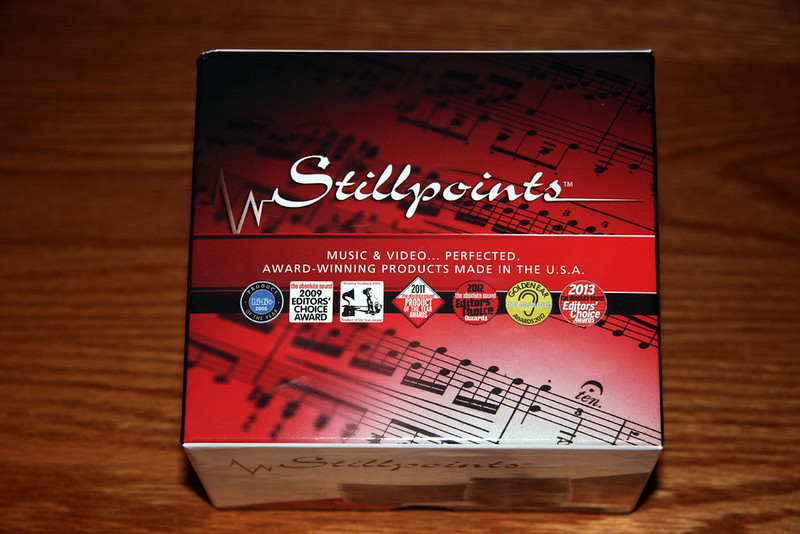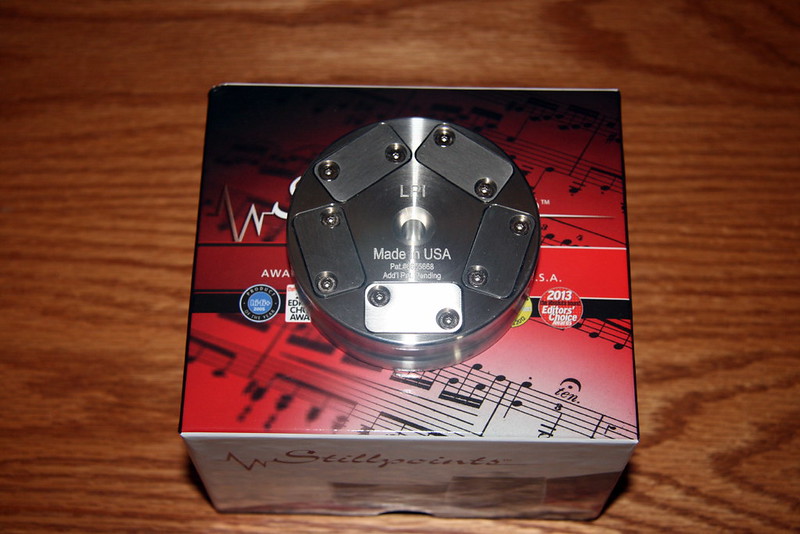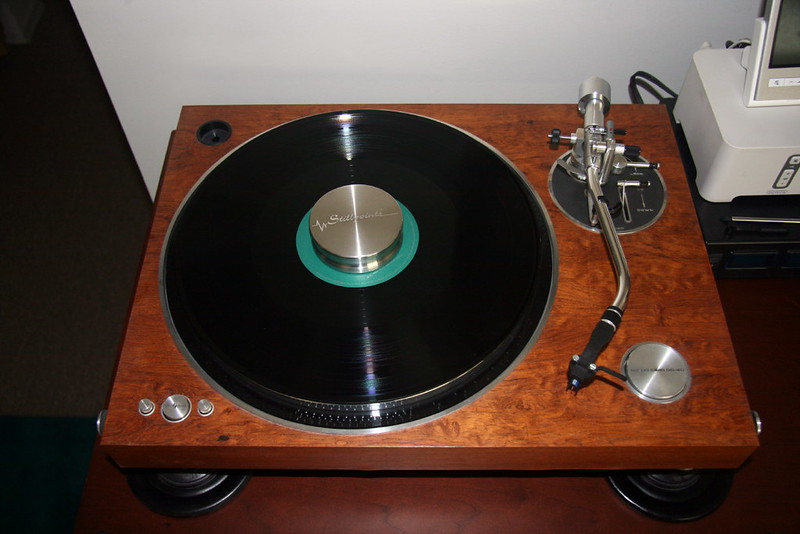 Santa arrived early.
Santa arrived early. I was extremely fortunate a couple days ago to have a wonderful gift arrive. I could have left it wrapped and waited until Christmas morning…..or not. The child in me chose the latter. I know, another black mark on the naughty list but I can live with that. So out came the pocket knife to slice open the tape and what to my wondrous eyes should appear? Wow, the meticulously designed and expertly crafted Stillpoints LP Isolator. I broke into my happy dance. Thankfully there's no video of that to haunt me later.
The Stillpoints LP Isolator is a record weight that sits over the spindle of your turntable on top of the record label. Its purpose is to absorb the micro vibrations that can interfere with a stylus’s ability to accurately contact and track the record groove. To call the Stillpoints LP Isolator a record weight is a bit of a misnomer. It is actually a vibration absorption system that aids the removal of extraneous energy from an LP album and turns this unwanted energy into heat. In other words, the LP Isolator will mechanically lower your noise floor. This is always a good thing in any audio system.
Stillpoints manufactures two versions of their LP Isolator. One is designed to sit over a normal height turntable spindle. The second version is referred to as the Deep LP Isolator and has the spindle hole drilled completely through the stainless steel center. The LP Isolator is heavy in my hand compared to my other two record weights, the Alchemist record weight and the Aluminati Sound record weight. On a suspended turntable you will notice the turntable lower itself on its suspension when you place the Stillpoints LP Isolator on the platter spindle. I think the LP Isolator weighs close to 24 ounces but that’s just a ballpark guess from holding it in my hand.

Getting down to the business of playing vinyl and putting the Stillpoints LP Isolator to work I began with the studio system and my Michell Gyro SE turntable, SME 309 tonearm, and Ortofon Cadenza Black moving coil cartridge. Unfortunately I discovered I cannot use the LP Isolator on the Michell Gyro SE because this turntable has the upgraded threaded spindle that allows the Michell threaded clamp to be used. The parts that accommodate the threaded spindle have a center piece the rises slightly above the platter surface so when the Michell clamp is threaded down and tightened it puts pressure on the outer edge of the LP label area to press the record into full contact with the platter. This raised fitting cannot be removed. Consequently the Stillpoints LP Isolator just sits on the spindle but does not press the LP to the platter’s surface. It is a no-go for the Stillpoints LP Isolator on my Michell Gyro SE turntable. I did notice on the Mitchell Gyro SE, which is a suspended turntable, that the weight of the Stillpoints LP Isolator caused the suspension springs to compress a bit under the additional weight but did not cause the suspension to bottom out.
Next up was my Micro Seiki DD-40 turntable, M505A tonearm, and Ortofon Cadenza Blue moving coil cartridge. Placing a vinyl LP on the turntable platter of the DD-40 allows the record to fully contact the platter mat, thus allowing the Stillpoints LP Isolator to work perfectly with this turntable. I guess one turntable out of two isn’t bad, although I would have preferred to use the LP Isolator with the studio system. The Ortofon Cadenza Blue’s sound is open, dynamic, and involving, with an excellent signal to noise ratio. Even without a record weight the vinyl performance of the Micro Seiki DD-40 with the Cadenza Blue is very good through the moving coil phono stage of the McIntosh C2300 with Gold Lion gold pin tubes, McIntosh MC601 amplifiers and the PMC EB1i speakers.

I decided to compare an album track without the Stillpoints LP Isolator, then the same track again with the Stillpoints LP Isolator to determine if I could actually hear a difference. I began with Rosanne Cash –
Rhythm & Romance album, “I Don’t Know Why You Don’t Want Me”. Without the Stillpoints LP Isolator I was quite pleased with what I was hearing, but not surprising the performance was improved once the LP Isolator was placed on the spindle. Rosanne’s voice was easier to distinguish from the background vocals. It seemed as though there was additional space between the vocals and the instruments. Guitar, electric piano, bass and drums developed slightly clearer focus and the timbrel quality of the bass sounded more accurate. I would not call the differences revolutionary, more like evolutionary. Improved air, resolution and space between voices and instruments were easily heard but not necessarily what would be described as a huge difference. The improvements are subtle but clearly discernable.
Listening to the Rolling Stones –
Undercover, “Undercover Of The Night” the experience was similar. Without the Stillpoints LP Isolator I was enjoying the LP track, tapping my foot and remembering how the Stones really rocked back in the early 80’s when this LP was recorded. Adding the Stillpoints LP Isolator to the turntable definitely improved the overall focus of each performer. Mick Jagger’s voice was better isolated from Keith Richards voice. It became easier to hear both Keith’s and Ron Wood’s guitars. Charlie Watts drums took on an improved sense of dynamics and I began to hear a faint background drum reverberation I had not been aware of before using the Stillpoints LP Isolator. That was quite a surprise.
I played several other album tracks from LP’s of Shadowfax, Spyra Gyro, Houston Person, and Rickie Lee Jones, all with very similar results. In every case I found a subtle improvement to the sense of space around voices and instruments, plus there was a new timbrel accuracy to bass. I attribute these differences to a quieter background. The Stillpoints LP Isolator appears to remove the micro vibrations coming from platter rotation and the energy that a stylus itself redirects back into the vinyl as it tracks an LP’s groove walls. Whatever it is doing, there is a positive effect on what I was hearing. It is clear the Stillpoints LP Isolator elevates my vinyl listening experience. Once again, the improvements I heard were subtle but not so subtle as to be difficult to identify and in all cases were positive improvements on the performance. I have to imagine the more sophisticated your vinyl playback system is the greater the results will be afforded. Another plus, no break-in time required. The Stillpoints LP Isolator delivers right out of the box. For serious vinyl aficionados, I think the Stillpoints LP Isolator might just be the best and possibly the very last record weight you will ever need.